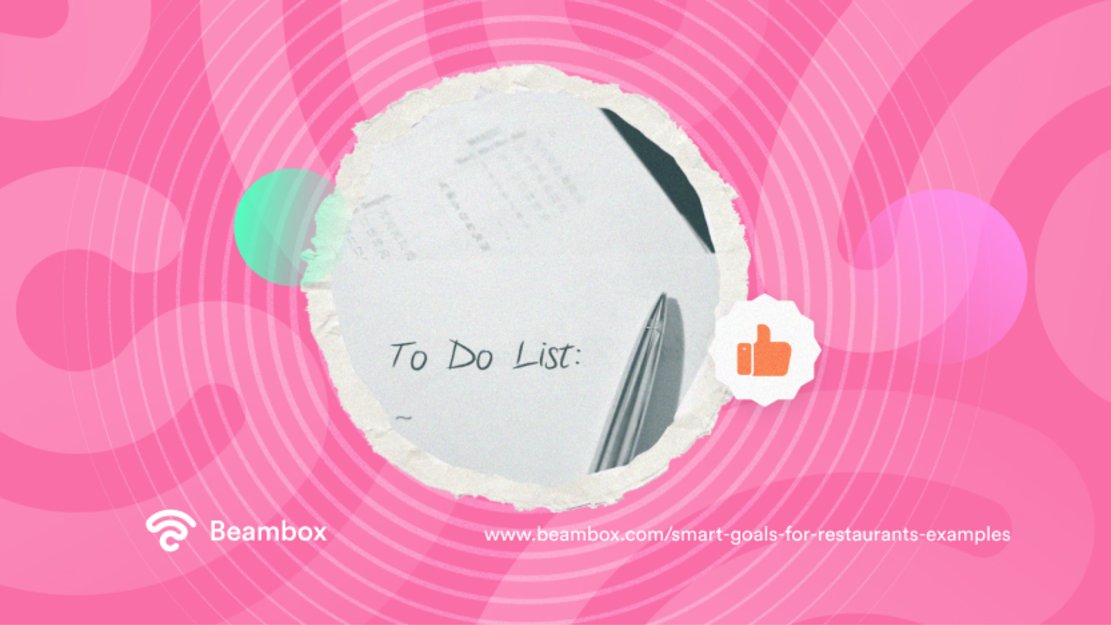Setting goals to achieve success is the most practical way to sustain your business. However, you must set SMART goals, not just random ones. Looking into SMART goals for restaurant examples will lead you to continuous success.
SMART goals are not only a literal term but also an acronym that highlights the traits of these goals. If you break the word, you will get specific, measurable, attainable, relevant, and timely.
This doesn’t mean you must create five different versions for each goal, but rather, each goal should have these traits.
This article is your lead if you want to learn more about SMART goals for restaurant examples. Here, you can learn about planning, setting, and implementing SMART goals for generating more revenue and improving your services.

Set Yourself up for Success: What Are SMART Goals for Restaurants?
Now that you know the basics of SMART goals, let’s understand each term separately.
Specific means knowing what you want to achieve in your restaurant business. Let’s understand this with SMART goals for restaurant examples.
Firstly, if you wish to improve sales for your restaurant, make it clearer by adding how much. Say you want a 20% revenue increase next month. This is also a measurable goal. After having a specific and measurable count, check if a 20% increase is attainable.
Attainable goals mean practical goals because you do not want to follow a lost cause. Here comes the fourth term, relevant, where you check whether your goal is relevant to your needs or not.
For example, if it is the right time to focus on revenue or if you need investments to expand your business. If you think the goal is relevant, proceed to make it happen in the appropriate time frame.
Time is the last of the terms of SMART goals. You need practical timing to generate revenue or get online traffic because delaying the process is never ideal.
Also, understand the difference between objectives and goals. The goal is a long-term achievement, while the objective is a short-term action crucial to reach the goal. Having reasonable objectives will help you attain the goal faster.
Why Do SMART Goals for Restaurant Examples Matter?
SMART goals are essential for the restaurant business for multiple reasons. Whether it is a restaurant marketing plan or a general business plan, SMART goals give you more chances of success. However, the best path is to learn from the existing SMART goals for restaurant examples. Here’s why they matter:
- More direction and clarity: When you work through SMART goals, you can stay focused with more clarity in your vision. It is helpful to keep going in one direction because you have a do’s and don’ts roadmap.
- Your success is measurable: When you put a number to the goal, you can analyze the progress. Evaluating each step along the way reduces the chances of big failures.
- Your goals are achievable: It is easy to execute one thing at a time. Therefore, it will be more realistic to allocate time, energy, and resources to small goals that you can practically achieve.
- Your planning becomes simple: When you have a particular goal, you can plan the process accordingly. It helps to decrease the distraction and time wasted on unnecessary activities.
- A sense of motivation: When you and your team are completing small milestones, you stay motivated. Visible success gives a sense of achievement and keeps the team going towards the larger goal.

Master the Execution: How To Set SMART Goals for Restaurants Examples?
Now that you have the knowledge of SMART goals for restaurant examples let’s learn how to set them.
If your goal seems unclear, make sure you apply the SMART strategy. To start the process, you must make a statement that makes the goal seem realistic.
For example, if you want to reduce food waste, give it a number such as “food waste reduction by 5%.” After a believable statement, apply the other traits of a SMART goal. Once you have a clear view of the goal and the plan to achieve it, share it with your staff.
Your team must know about your goals and the process to achieve them. Moreover, if you know about the limitations of the process, you can overcome them along the way.
Now that you know your viewpoint, you can set smaller goals that will assist the process of reaching the final goal.
For instance, If you want to reduce 5% food waste in the next three months, you can analyze the necessary steps. You can work on reducing the portion size of the menu items. You can also educate the customers or create food compost for your restaurant.
Remember to keep the staff active and start the necessary groundwork. In the end, consider the possible failures and alternative planning to make the goal successful.
5 Examples of SMART Goals for Restaurant Managers To Create Your Own
In this section, you will learn where you can use the SMART goals in your restaurant business. You can gain many aims by exploring the right SMART goals for restaurant examples.
Keep in mind the background of SMART and implement it in any goal you want to complete in 2023. Taking a look at the following examples of SMART goals for restaurant managers will help shape yours.
SMART Goals for Restaurants Example #1: Sparking Up Your Finances
By now, you must have a good idea that boosting the finances is the first goal of every restaurant manager. It is one of the most meaningful SMART goals for restaurants example.
Sales are necessary to generate enough profit margin for a restaurant’s sustainability. An average restaurant makes 7% profit. But what if it’s not enough, or you want to increase sales?
If it is scary to boost sales, you can use SMART goals and go ahead gradually. For example, what do you need to do if you want to take your profit from 7% to 10%?
Now, see if it is doable or not. If yes, see if it’s necessary at this point of the year. If your mind answers “yes” again, consider a timeline because a time boundary is vital to keep yourself motivated. If you leave the time open, you will not achieve your goal any time soon.
Moreover, increasing the profit with a smaller margin is more beneficial for maintaining long-term revenue. The reason is that there are slight chances of failure with small changes so that you can rectify them timely.

SMART Goals for Restaurants Example #2: Turning up the Dial of Your Service Quality
SMART goals for restaurant examples also include improving customer service. You can use multiple strategies but never go to the hard step before correcting the basics.
If you want to get more reviews, the easiest trick is training your employees. It is a short-term goal, so you can achieve it using the SMART strategy.
For instance, “staff training within one month for improving customer satisfaction.” It seems more actionable and is a first step towards lasting goals.
Or you can have a bigger goal of getting a rating of 4.5 a year. The staff training will act as an objective for improvement in rating. Your restaurant’s reputation will automatically increase because of more customer satisfaction following the staff training.
Additionally, you can use social WiFi hotspots, digital billing, or POS systems for feedback. Using more technology will improve your rating on any restaurant review site.
SMART Goals for Restaurants Example #3: Spreading the Word About Your Restaurant
SMART goals for restaurant examples also help restaurant owners improve their marketing plans. There are a lot of things you can do here to meet your marketing needs.
First, think about your main goal and create short-term strategies for getting there. Let’s assume that you want to increase your online reservations by 25% and get 10k monthly website visits.
As overwhelming as achieving these goals seems, the SMART strategy can take you with just a little effort. Start by creating informative content for your website and optimize it for search engines. For example, if you have a vegan menu option, you can share the benefits of veganism on your website’s blog.
Or, if you’re into fine dining with many menu choices, educate your audience about the right way to pair dishes. Combining this free value with SEO will help you appear higher on Google and increase your visits.
On the other hand, increasing online reservations will require aggressive marketing campaigning. Take appetizing shots of your food and highlight your unique points when posting. You can also take the more traditional route with flyers, billboards, etc.
SMART Goals for Restaurants Example #4: Retaining Employees and Customers
Now, let’s use SMART goals for restaurant examples to retain employees and customers. There is a 1.2% decrease in restaurant foot traffic and a 75 % increase in the employee turnover rate. If you have a restaurant, you might be facing the same issue.
You must be wondering how to regain the numbers and retain employees in a short period—no need to worry when you have SMART rules to get on track.
First, estimate how many employees you want to hire. Now, narrow it down to a measurable number, such as 10 or 15. See if you have the time and energy to execute the goal. If you have the determination to do so, set a time frame.
Start by hiring a small number of employees and give benefit packages. Move on to hiring more with the increase in the size of your business.
Similarly, there are multiple strategies you can use to attract customers. Using loyalty programs, gift cards, and free deliveries when possible makes a huge difference.
Moreover, engage your community by sponsoring food at local events. This will help you gain popularity. Maintaining quality food is another way to attract customers. If they do not get delicious food, they won’t come back.
Additionally, you can use customer engagement strategies such as “buy one, get one free” or deals for special events. This will also help you get more customers within your time range.

SMART Goals for Restaurants Example #5: Taking Your Kitchen to New Heights
Last but not least, the SMART Goals for restaurants example can give your kitchen a refreshing spin.
Improving the menu is not as difficult as retaining employees or customers. Here, you just need a definite budget to launch a new menu.
Remember, do not rush to huge changes in food items. Instead, use cost efficiency to build a menu. But first, evaluate your needs.
For example, how many items do you want to launch? Writing “2 new items in the main course” gives a clearer picture of the goal.
Keep in mind that adding two items to the main course is just the start of changing the whole menu. Take this step as an objective and make the complete shift with time.
You can use the menu pricing strategy to make the food items profitable. Moreover, you can also use menu engineering to achieve these SMART goals examples for restaurants.
Learn SMART Goals for Restaurant Examples To Hit the Success Accelerator
Wrapping up the discussion of SMART goals for restaurant examples, nothing beats a properly planned goal.
To set such goals, add a number to a vague wish. However, absurd goals like getting 1,000 followers per day are unachievable, so stay away from such expectations. They will only disappoint you. Moreover, you must also learn to keep track of your situation after implementing SMART goals to achieve anything.
It is necessary to review your process and assess what you are doing right or wrong. Don’t forget that going one step at a time and setting smaller goals is more profitable.
If you want to scale your success, try out Beambox’s WiFi marketing platform. Over 12,000 venues are using Beambox to improve their online reputations and automate their marketing campaigns. Beambox does not require additional hardware and integrates with most internet systems. Try it for free for thirty days.
Get Started With Free WiFi Marketing
Beambox helps businesses like yours grow with data capture, marketing automation and reputation management.
Sign up for 30 days free